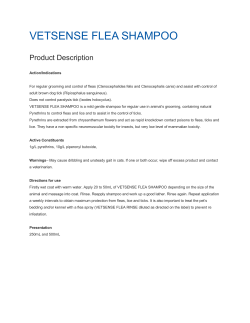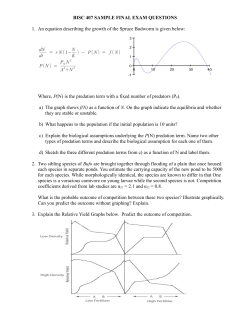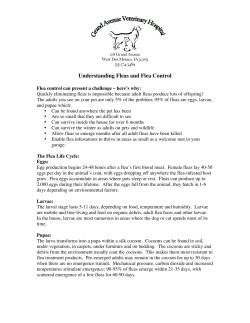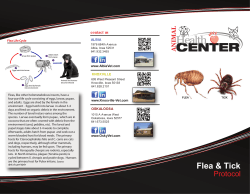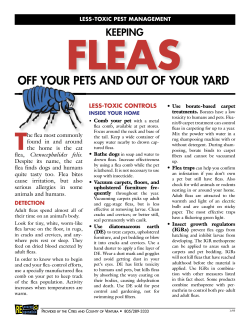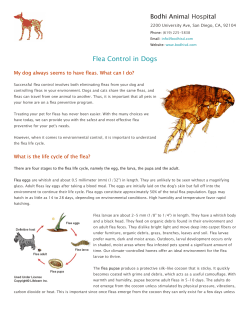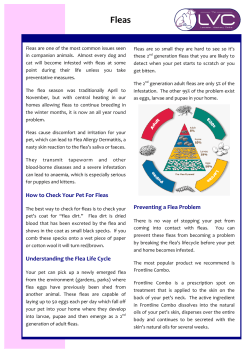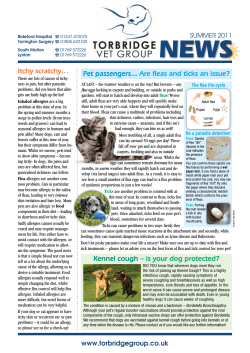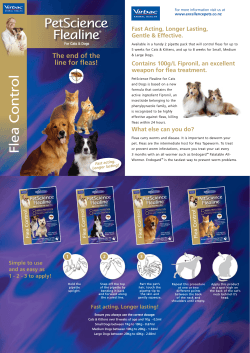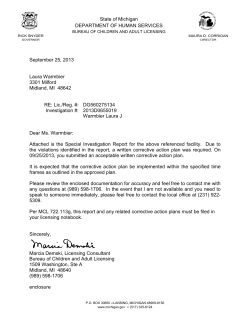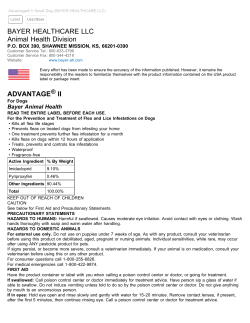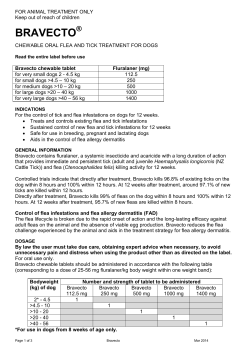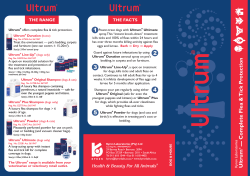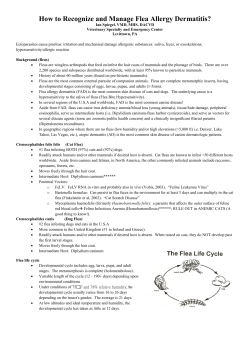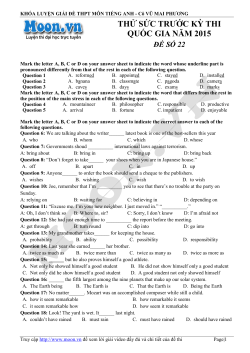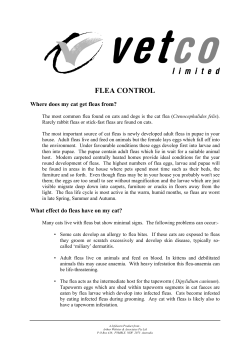
FLEAS Working Together N U M B E R F O...
FLEAS WORK STUDY | OPPORTUNITIES FOR PROFIT N U M B E R WorkingTogether F O U R WORK STUDY | OPPORTUNITIES FOR PROFIT N U M B E R F O U R Flea Species Description There are around 2500 different species of fleas described worldwide with another 500 awaiting classification. The predominant flea of modern homes in the Western World is Ctenocephalides felis – the cat flea – responsible for around 70% of all flea complaints. Fleas belong to the order Siphonaptera. They vary in size from 1mm, such as the rabbit flea, to the mole flea that can be up to 8mm. Other species include the dog flea, Ctenocephalides canis found on humans and pets, particularly in their bedding, and the human flea, Pulex irritans is also found on humans, in bedrooms and is capable of breeding on pigs, badgers, foxes and hedgehogs. The human flea is however rare. Others, that may be encountered include the rabbit, bird, hedgehog and mole fleas. Fleas vary from being light brown in colour to nearly black although most encountered in the work of a pest control operator are a reddish brown. They are flattened from side to side in appearance, allowing them to move easily through hair and fur and are covered in backward facing bristles. They have well developed muscles in the hind limbs and a unique skeletal structure which are special adaptations for jumping. Fleas have no wings (although transitory wing buds may appear in pupae of some species), reduced or no compound eyes and piercing and sucking mouth parts. Getting Bitten? It may be static Adult fleas live as parasites on warm-blooded animals and although they show host preference they will feed on sources of blood in the absence of their normal host. Some flea species are unable to breed without the presence of the blood from their definitive host. On occasions, office workers may complain of being bitten by insects but when pest controllers are brought in, no signs of insect infestation are found. The reason could be attributed to ‘Cable bugs’. Life Cycle ‘Cable bugs’ refers to static electricity. In environments where there are sources of static, such as the computer console and, especially where nylon carpeting exists, a phenomenon occurs which results in realisticlooking bite marks on the skin that look and feel exactly like flea bites. In rooms containing a lot of paper, electrical equipment and fibres, static electricity can cause particles of carpet fibres, paper splinters or fibreglass fibres to jump onto arms and legs. When static electricity builds up, tiny sharp particles of nylon carpeting can actually leap out of the carpet and embed themselves in the skin. (Paper shards in the air are also attracted to exposed parts of the body and this can give rise to biting insect complaints) In such cases the problem can be solved by an anti-static preparation. (Or by ventilating poorly ventilated stationery cupboards). This is an antistatic and cleaner for treatment of carpets and other surfaces and will prevent the effects of static for weeks before retreatment is necessary. Anti-static preparations are dilutable in water and are economical in use. (A meter is available that allows measurement of static and can often assure both management and staff of affected premises that the problem is not caused by insects. A flea trap that uses the heat from a bulb to attract fleas to a sticky pad can also be utilised.) A single female is capable of producing several hundred eggs in her life-span. The eggs hatch after about a week and the legless, white thread-like larvae feed on organic waste including undigested blood and excreta left by adults. The larvae are about 1.5mm long at this stage and are identified by their eyeless, brown head, biting jaws, 3 segmented thorax and 10 segmented abdomen covered in bristles, with peg-like protrusions on the final segment. The larvae become grey in colour as they grow and after about 2-3 weeks, having moulted twice, reach a length of 5mm. At this stage they begin to spin silken cocoons in which they pupate. These cocoons are tent shaped and incorporate dust particles etc which help to camouflage the pupa and also makes them difficult to penetrate with a water base insecticide. This is a major problem in unoccupied properties and the use of an oil based insecticide is recommended for these areas or the application of a desiccant dust along joints in floor boards or wood block floors. These turn brown as they mature to become adults and are capable of remaining dormant for 8 months until stimulated to emerge for a feed. It is known that fleas breed close to their hosts in dust, sweepings, dirt, cracks and crevices and general rubbish. The whole cycle from egg to adult takes about a month in summer, much longer at lower temperatures. When unoccupied properties need to be visited, workmen can be protected from bites by wearing overboots that have been treated with a repellent. Life Cycle Nuisance Factor Control Fleas will often go unnoticed until, towards August and September, either people are bitten or pets begin to suffer. When very hungry, fleas will jump onto people (not their preferred host) feed a little on blood, then leap off again to await a more suitable host. Despite the natural misfortunes common to all creatures living under uncontrolled conditions, such as predators, parasites, diseases and extremes of temperature, fleas continue to be a pest and their control remains a necessity. Bites to humans can cause intense reddened irritation around a central red spot which can last for up to 2 days. First bites are not usually responsible for serious reactions although subsequent ones may lead to hypersensitivity among some people. Flea control is best directed at the free-living stages, when the flea is not on the host. Effective control means halting the flea life cycle rather than just treating the adult flea. It is thought that up to 50% of all skin diseases suffered by cats and dogs are caused by allergic reactions to flea bites which attack all pets at one time or another during their life. Fleas are capable of spreading serious disease. The most critical of these being the infectious Bubonic plague, transmitted to man by the rodent flea that carries the causative bacillus from infected rats. This flea is responsible for carrying murine typhus. While disease transmission is still prevalent it is now the case that fleas are considered more of an irritation and the cause of much social stigma. On occasions, psychological problems arise in the form of delusory parasitosis (a condition where the victim imagines that he/she is infested with insects). The correct flea control measures can only be decided once the level of infestation has been determined. In many cases, infestations (even of spotlessly clean homes) can usually be attributed to pets, who may well have picked up fleas from outside sources. Other possible hosts need to be identified should this not be the case. Birds’ nests for instance are a common source of fleas outside the home. Before applying any treatment, floors and furniture must be thoroughly cleaned and vacuumed. Particular attention should be given to pets’ bedding and places where pets frequent. Domestic pets should also be regularly treated with an appropriate veterinary product. Infested clothing, beds and bedding should be destroyed or thoroughly cleaned and accumulations of debris destroyed. Thoroughness is vital when treating any flea infestations as problems can quickly re-surface if an area is not treated sufficiently. Treatments can be carried out by using conventional residual insecticides or with a combined treatment using an insect growth regulator (IGR). Possible hosts should also be carefully treated (by the owners or in the case of birds nests the nests should be removed and the area treated with an insecticide) ensuring that the manufacturer’s instructions are closely adhered to. Where the infestation has occurred as a result of a rodent problem, suitable rodenticides should be used. Application Products There is a wide range of equipment available to apply insecticides according to their formulation. It is recommended that only those manufactured for professional use are utilised to ensure accurate application. Alphamax Plus Deltamax AF Insect Monitor Flea Trap Ficam W No-Stat Gloria 5 Ltr Skoosh VET-KEM Acclaim Insectaban Cimetrol Tenopa ULV 500 Electrostatic Locator Prevent Spray - Insect Repellent The Killgerm range of products and applications equipment is the most comprehensive in the industry. Whatever the need Killgerm have the equipment and products to provide a professional solution. Killgerm Chemicals Limited PO Box 2, Ossett, West Yorkshire, WF5 9NA. Tel: 01924 268 400 Fax: 01924 264 757 Email: info@killgerm.com • http://www.killgerm.com A member of the Killgerm Group of Companies WorkingTogether KG 8308 / 4.10 Nylar 4EW
© Copyright 2025
